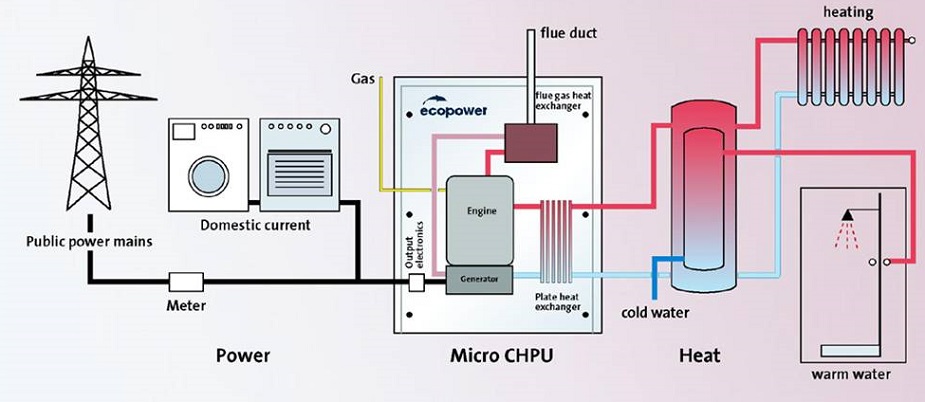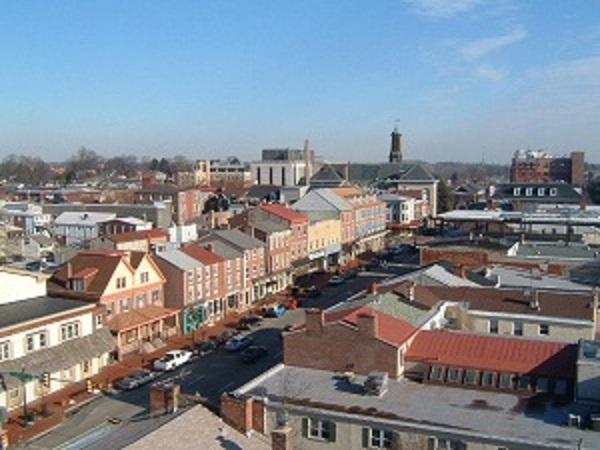Implementing Combined Heat and Power Projects
CHP reduces the environmental impact of power generation by promoting the use of efficient, clean, and reliable approach to generating power and thermal energy from a single fuel source.
CHP can increase operational efficiency and decrease energy costs, while reducing the emissions of greenhouse gases, which contribute to global climate change.

Objective is to save time and money, reduce business risk and environmental impacts, and improve the power reliability of your facility in five steps:
o Qualification Determine whether CHP is worth considering at your facility
o Level 1 Feasibility Analysis Identify project goals and potential barriers. Quantify technical and economic opportunities while minimizing time and effort
o Level 2 Feasibility Analysis Optimize CHP system design, including capacity, thermal application, and operation. Determine final CHP system pricing and return on investment
o Procurement Build a CHP system according to specifications, on schedule and within budget
o Operation & Maintenance Maintain a CHP system that provides expected energy savings and reduces emissions by running reliably and efficiently

projects designed to meet specific operational needs and integrate seamlessly into existing mechanical and electrical systems
Economic suitability for CHP is based on current and future fuel costs and utility rates; planned new construction or heating, ventilation, and air conditioning (HVAC) equipment replacement; and the need for power reliability at the site.
CHP project economics are greatly affected by utility policies at the local state and federal level
The Technical Potential for CHP is based on the coincident demand of power and thermal energy. Power can include both electricity and shaft power, which can be used for mechanical purposes. Thermal demand can include steam, hot water, chilled water, process heat, refrigeration, and dehumidification. A CHP system can be designed to convert waste heat into various forms of thermal energy to meet different facility needs, including heating hot water in the winter and chilling water in the summer.
Operations and Maintenance $0.005/kilowatt-hour (kWh) – $0.015/kWh for maintenance, depending on type of equipment and operations and maintenance (O&M) procurement approach; possible cost for energy consultant to negotiate fuel purchase, depending on system size and in-house capabilities.
Benefits CHPs achieve efficiencies of 60 to 80 percent, compared to average fossil-fueled power plant efficiencies of 33 percent in the United States. These translate to:
• Reduced total fossil fuel use.
• Lower operating costs.
• Reduced emissions of regulated air pollutants.
• Reduced emissions of greenhouse gases.
• Increased reliability and power quality.
• Reduced grid congestion and avoided distribution losses.

CHP and biomass/biogas funding opportunities
Financial incentives, such as grants, tax incentives, low-interest loans, favorable partial load rates (e.g., standby rates), and tradable allowances.
Regulatory treatment that removes unintended barriers to CHP and biomass project development, such as standard interconnection requirements, net metering, and output-based regulations.
State and federal incentives applicable to CHP systems, such as direct financial incentives or favorable regulatory treatment.
Find out if your facility is a good candidate for CHP














 Georgetown is located 30 miles from Austin on the northeastern edge of Texas Hill Country. Portions of the town are located on either side of the Balcones Escarpment, a fault line characterized by black, fertile soils of the Black land Prairie, with the west side consisting of hilly, limestone karst formations.
Georgetown is located 30 miles from Austin on the northeastern edge of Texas Hill Country. Portions of the town are located on either side of the Balcones Escarpment, a fault line characterized by black, fertile soils of the Black land Prairie, with the west side consisting of hilly, limestone karst formations. History the earliest known historical occupants of the county, the Tonkawas, were a flint-working, hunting people who followed buffalo on foot and periodically set fire to the prairie to aid them in their hunts. During the 18th century, they made the transition to a horse culture and used firearms. The town was named for George Washington Glasscock who donated the land for the new community; the early American and Swedish pioneers were attracted to the area’s abundance of timber and clear water.
History the earliest known historical occupants of the county, the Tonkawas, were a flint-working, hunting people who followed buffalo on foot and periodically set fire to the prairie to aid them in their hunts. During the 18th century, they made the transition to a horse culture and used firearms. The town was named for George Washington Glasscock who donated the land for the new community; the early American and Swedish pioneers were attracted to the area’s abundance of timber and clear water. Southwestern University the Oldest University in Texas is one-half Mile from the Historic Square
Southwestern University the Oldest University in Texas is one-half Mile from the Historic Square Population growth and industrial expansion continued modestly in the 20th century until about 1960, when residential, commercial, and industrial development, due to major growth and urban expansion of nearby Austin, greatly accelerated. Currently, Georgetown is served by the appropriately named Georgetown Railroad, a short line railroad that connects with the Union Pacific Railroad at Round Rock and at Granger.
Population growth and industrial expansion continued modestly in the 20th century until about 1960, when residential, commercial, and industrial development, due to major growth and urban expansion of nearby Austin, greatly accelerated. Currently, Georgetown is served by the appropriately named Georgetown Railroad, a short line railroad that connects with the Union Pacific Railroad at Round Rock and at Granger. Connect for Travel to Georgetown and Texas
Connect for Travel to Georgetown and Texas

 The Rockpile Museum documents life in early Gillette. After the railroad moved to Sheridan, Gillette survived in order to serve the ranchers, cowboys, and homesteaders who were trying to make a life in the countryside surrounding the town. Cattlemen drove their herds into the livestock yards at Gillette for sale and transportation to the markets back east. Industrious citizens set up businesses to cater to these people and any who passed through. Livery barns, stables, and blacksmiths popped up to house travelers’ horses and haulers’ draft teams. Bars and brothels catered to those who pursued that lifestyle.
The Rockpile Museum documents life in early Gillette. After the railroad moved to Sheridan, Gillette survived in order to serve the ranchers, cowboys, and homesteaders who were trying to make a life in the countryside surrounding the town. Cattlemen drove their herds into the livestock yards at Gillette for sale and transportation to the markets back east. Industrious citizens set up businesses to cater to these people and any who passed through. Livery barns, stables, and blacksmiths popped up to house travelers’ horses and haulers’ draft teams. Bars and brothels catered to those who pursued that lifestyle. Tourism Gillette’s inclusion on the Black and Yellow Trail in 1912, a highway extending from the Black Hills to Yellowstone, brought many different travelers and tourists into town via automobile resulting in construction of tourist camps, cottages, and motels along with cafes and eateries.
Tourism Gillette’s inclusion on the Black and Yellow Trail in 1912, a highway extending from the Black Hills to Yellowstone, brought many different travelers and tourists into town via automobile resulting in construction of tourist camps, cottages, and motels along with cafes and eateries. Geography Gillette is situated between the Bighorn Mountains and the Black Hills in the Powder River Basin. Devils Tower rises 1,267 feet – 386 m – above the Belle Fourche River; the summit is 5,112 feet – 1,559 m – above sea level.
Geography Gillette is situated between the Bighorn Mountains and the Black Hills in the Powder River Basin. Devils Tower rises 1,267 feet – 386 m – above the Belle Fourche River; the summit is 5,112 feet – 1,559 m – above sea level.

 Ethical not Technical as the documentary Surviving Progress points out, solutions to climate change and mankind’s condition on planet earth can be found less in technological advancement and more in ethical and political considerations; people tend to do and want what others do and want.
Ethical not Technical as the documentary Surviving Progress points out, solutions to climate change and mankind’s condition on planet earth can be found less in technological advancement and more in ethical and political considerations; people tend to do and want what others do and want. At this point, technological as well as politically and economically feasible solutions can be adopted.
At this point, technological as well as politically and economically feasible solutions can be adopted. ESPCs and CHP are utilized in a variety of applications:
ESPCs and CHP are utilized in a variety of applications:
 ESAs are the Energy Efficiency Equivalent of a Power Purchase Agreement
ESAs are the Energy Efficiency Equivalent of a Power Purchase Agreement Energy Management for Small and Medium-sized Commercial Buildings
Energy Management for Small and Medium-sized Commercial Buildings Benefits resulting from the application of ESAs include energy efficiency, water conservation, emissions reduction and streamlined contract funding for energy management projects, through access to private-sector expertise, built-in incentives to provide high-quality equipment, and project commissioning infrastructure improvements. Project management ensures building efficiency and new equipment without upfront capital costs as well as energy and related operation and maintenance cost saving guarantees.
Benefits resulting from the application of ESAs include energy efficiency, water conservation, emissions reduction and streamlined contract funding for energy management projects, through access to private-sector expertise, built-in incentives to provide high-quality equipment, and project commissioning infrastructure improvements. Project management ensures building efficiency and new equipment without upfront capital costs as well as energy and related operation and maintenance cost saving guarantees.

 Small and Medium-sized Commercial Buildings account for 95 percent of building stock and consume half the energy in a sector of the economy responsible for 20 percent of the total energy consumption.
Small and Medium-sized Commercial Buildings account for 95 percent of building stock and consume half the energy in a sector of the economy responsible for 20 percent of the total energy consumption. Controls Designers purchase all devices and controllers from single vendors instead of being able to choose optimal products, controls and services from different vendors to achieve widespread turnkey solutions that reduce installation and maintenance costs with seamless integration of HVAC, lighting, and plug load equipment as well as controllers from different manufacturers that offer plug-and-play functionality for the many system configurations found in smaller commercial architectures.
Controls Designers purchase all devices and controllers from single vendors instead of being able to choose optimal products, controls and services from different vendors to achieve widespread turnkey solutions that reduce installation and maintenance costs with seamless integration of HVAC, lighting, and plug load equipment as well as controllers from different manufacturers that offer plug-and-play functionality for the many system configurations found in smaller commercial architectures. Benefits include streamlined building operations, optimized energy usage, greater interconnection between building systems and a centralized control structure that facilitates demand response, savings and better integration with the electric power grid, energy savings of 10 percent for HVAC systems and 15 percent for lighting, increased participation in demand response programs, a cost-effective, open-source, plug-and-play building automation platform that is secure, scalable, and broadly interoperable, and support for the most prevalent communication technologies and protocols, including Ethernet, Wi-Fi and Smart Energy Profile.
Benefits include streamlined building operations, optimized energy usage, greater interconnection between building systems and a centralized control structure that facilitates demand response, savings and better integration with the electric power grid, energy savings of 10 percent for HVAC systems and 15 percent for lighting, increased participation in demand response programs, a cost-effective, open-source, plug-and-play building automation platform that is secure, scalable, and broadly interoperable, and support for the most prevalent communication technologies and protocols, including Ethernet, Wi-Fi and Smart Energy Profile.